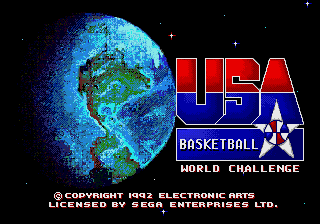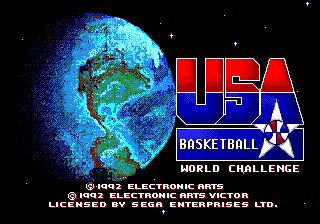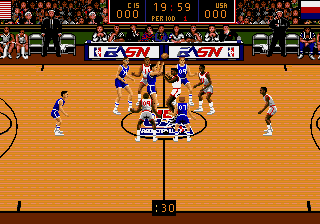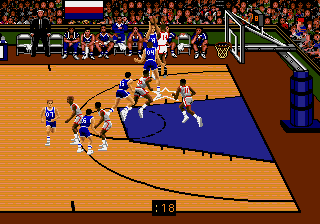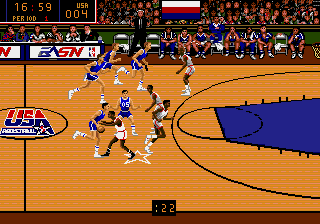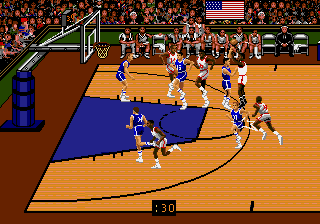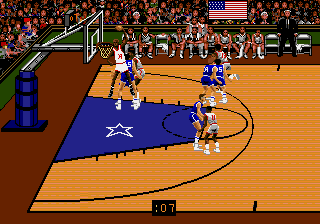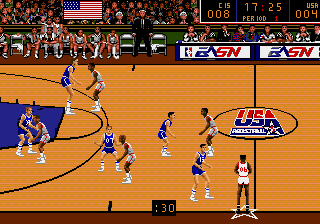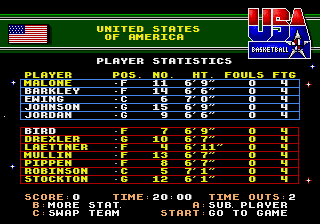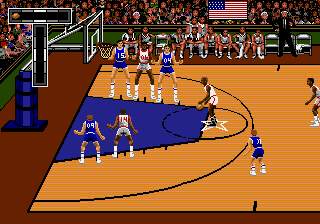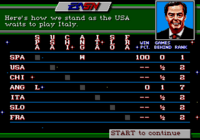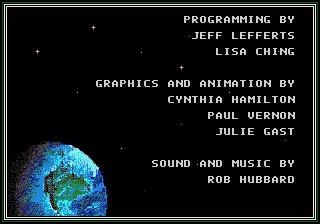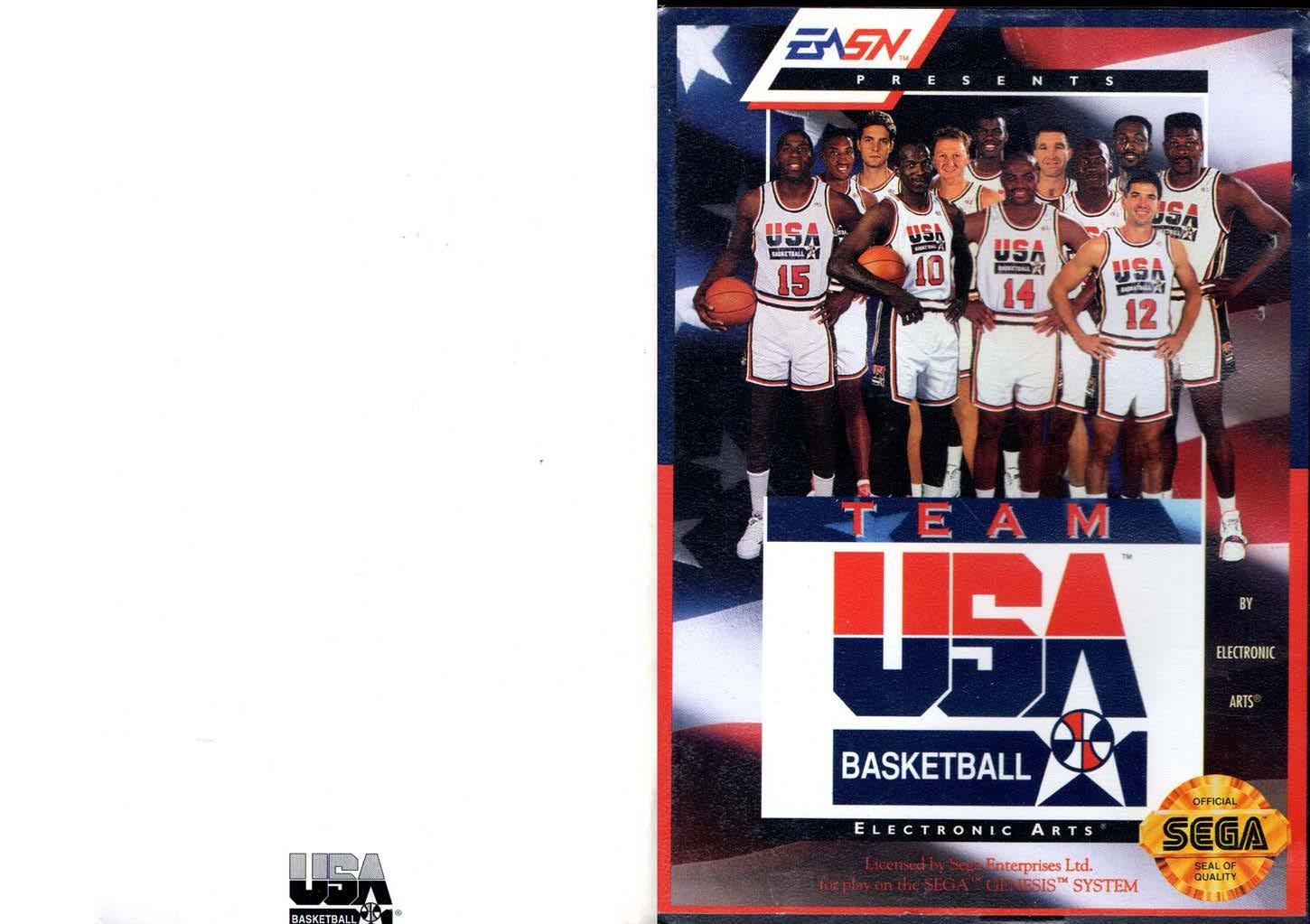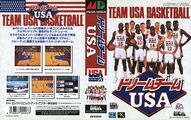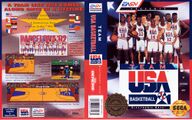Team USA Basketball
From Sega Retro
| ||||||||||||||||||||||||||||||
| Team USA Basketball | ||||||||||||||||||||||||||||||
|---|---|---|---|---|---|---|---|---|---|---|---|---|---|---|---|---|---|---|---|---|---|---|---|---|---|---|---|---|---|---|
| System(s): Sega Mega Drive | ||||||||||||||||||||||||||||||
| Publisher: Electronic Arts (US, Europe), Electronic Arts Victor (Japan) | ||||||||||||||||||||||||||||||
| Developer: Electronic Arts | ||||||||||||||||||||||||||||||
| Supporting companies: E.J. Sarraille Design Group (package design) | ||||||||||||||||||||||||||||||
| Genre: Sports[1][2] (basketball) | ||||||||||||||||||||||||||||||
| Number of players: 1-2 | ||||||||||||||||||||||||||||||
|
Team USA Basketball, known in Japan as Dream Team USA (ドリームチームUSA), is a 1992 basketball game for the Sega Mega Drive by Electronic Arts.
Its name refers to the United States national basketball team, making this one of the first, if not the first, basketball games with a focus on international basketball teams rather than US city teams. The 1992 United States Olympic basketball team was nicknamed the "Dream Team" as it featured many of the greatest players in the NBA at or near the peak of their careers: Michael Jordan and Scottie Pippen of the Chicago Bulls, John Stockton and Karl Malone of the Utah Jazz, Magic Johnson of the Los Angeles Lakers, Larry Bird of the Boston Celtics, Patrick Ewing of the New York Knicks, Chris Mullin of the Golden State Warriors, David Robinson of the San Antonio Spurs, Charles Barkley of the Philadelphia 76ers, Clyde Drexler of the Portland Trail Blazers, and NCAA player Christian Laettner. The team was undefeated at the 1992 Summer Olympic Games.
Contents
Gameplay
The game is a five-on-five basketball simulation featuring international teams that competed in the 1992 Summer Olympic Games in Barcelona, Spain. It can be played by one or two players. It plays very similarly to previous games in Electronic Arts' NBA Playoffs series, with some modifications to account for the differences in the International Basketball Federation (FIBA) rules used at the Olympics. Games are divided into two halves rather than four quarters, the shot clock is 30 seconds rather than 24, players are ejected after five personal fouls rather than six, and the three-point line and key vary in size and shape.
There are fifteen teams and one court. Games are broken into two halves, and the team with the most points at the end wins. A basket from inside the three-point line is worth two points, and any other basket is worth three points. The three-point line on a FIBA court is closer to the basket than on NBA courts. In the event of a tie, the teams play five-minute overtime periods until a winner is decided.
Fouls are called for traveling (if a player moves after he stops dribbling), charging (running into a defensive player who is set), failing to shoot the ball after having it for 30 seconds, failing to advance the ball into the defense's half of the court within 10 seconds, crossing back into the offense's side of the court after crossing into the defense's side, failing to throw the ball back into play within 5 seconds, and running out of bounds with the ball. Most fouls give possession of the ball to the other team, but fouling another player gives him a free throw.
| Tip-Off | |
|---|---|
| At the beginning of the first and third periods, the teams meet in the center of the court and try to gain possession of a jump ball to start the game on offense. The tip-off starts by pressing START , then a player from each team jumps with | |
| Defense | |
| The player under control has a star follow him on the ground (white for player one, black for player two) and moves in any direction using the D-Pad. The player under control can be switched by pressing | |
| Offense | |
| The player with the ball has a star follow him on the ground (white for player one, black for player two) and moves in any direction using the D-Pad. The player dribbles automatically while moving.
The player starts a jump shot by holding The player can pass to ball to a teammate by pressing After the other team scores or commits a foul, the player's team gets possession of the ball. A player stands on the sidelines and throws the ball to the nearest teammate he is facing by pressing When the player's team has possession of the ball, the player can call a time-out by pausing the game with START , then pressing | |
| Free Throw | |
| An offensive player is given free throws if fouled by a defensive player. The offensive player gets one free throw if fouled while shooting and the shot goes in; the offensive player gets two free throws if the offensive player is fouled while shooting and the shot misses (three free throws if the shot was taken outside the three-point line) or if the offensive player is fouled when the defensive player reaches in and there have already been 7 defensive team fouls in the half. Second and third free throws are only done if the free throws taken before make it in.
Free throws use a "T-meter" that works similar to a golf game. A basketball moves back and forth through the horizontal bar first. Pressing |
Modes
There are two game modes:
- Exhibition: Plays a single game. It can be played by a single player against the computer, by two players (on the same team) against the computer, or by two players (controlling separate teams) against each other. There are three difficulty levels (Pre-Season, Reg-Season, and Showtime) for computer players, and players can select the length of each half (5, 10, 15, or 20 minutes) and the play mode (Arcade or Simulation). Players can select the same team twice for a mirror match.
- Tournament: Plays a tournament. All of the teams are divided into two pools of seven teams, then each team plays a preliminary round against every team in their pool. The four teams with the best records from each pool (eight teams total) advance to the medal round, which is broken into quarter-finals, semi-finals, and finals. If the player's team is eliminated in the semi-finals, the player plays a consolation game for the bronze medal. The loser of the finals wins the silver medal, and the winner is awarded the gold medal. This mode can be played by a single player or by two players cooperatively against the computer. It is always played at Showtime difficulty and using Simulation rules, but players can select the length of each half (5, 10, 15, or 20 minutes). The player is given a seven-character password after each game for continuing.
There are two play modes:
- Arcade: Players never tire. The game does not keep track of fouls. This mode is not available for Tournament games.
- Simulation: Players become fatigued over the course of the game. Players have a fatigue level (FTG) from 1 to 4 (with 4 being full strength) and start to move slower, jump shorter, and miss more shots when their fatigue level decreases to 2. Slams tire players out faster. Players must be rotated in and out of the game during time-outs or between periods so they can rest. The game keeps track of fouls and ejects a player after committing five fouls.
Teams
The teams in Team USA Basketball loosely reflect the nations that competed in basketball at the 1992 Summer Olympics. There are notable omissions, possibly to reflect the standings in the older 1990 FIBA World Championship, such as the inclusion of Yugoslavia, the champions from that tournament. The explanation behind choosing teams such as France and the Netherlands over more competitive countries such as Brazil is unclear.
Note that, at launch, Yugoslavia no longer existed as a country, and the CIS (Commonwealth of Independent States; formed after the breakup of the Soviet Union) had competed in its last sporting fixture under that name.
The All World team is composed of the best players from every team.
Before a match, the game shows a screen of information about each country playing (with the exception of the All World team).
 Angola
Angola Australia
Australia Canada
Canada China
China The CIS
The CIS Croatia
Croatia France
France Italy
Italy Lithuania
Lithuania Netherlands
Netherlands Slovenia
Slovenia Spain
Spain United States
United States Yugoslavia
Yugoslavia- All World
Versions
Localised names
| Language | Localised Name | English Translation |
|---|---|---|
| English | Team USA Basketball | Team USA Basketball |
| English (US) | Team USA Basketball | Team USA Basketball |
| Japanese | ドリームチームUSA | Dream Team USA |
Production credits
- Programming by: Jeff Lefferts, Lisa Ching
- Graphics and Animation by: Cynthia Hamilton, Paul Vernon, Julie Gast
- Sound and Music by: Rob Hubbard
- Executive Producer: Don Traeger
- Associate Producer: Happy Keller
- Assistant Producer: Gerald McLane
- Technical Director: Edwin Reich
- Original Design by: Robert Weatherby
- Design and Programming: Lisa Ching, Edwin Reich, Jeff Lefferts
- Original Design: Robert Weatherby
- Additional Design: Happy Keller
- Art: Cynthia Hamilton, Paul Vernon, Julie Cressa
- Producers: Don Traeger, Happy Keller
- Assistant Producer: Gerald McLane
- Technical Director: Edwin Reich
- Sounds and Music: Rob Hubbard
- Product Management: Karen Schulman
- Package Design: E.J. Sarraille Design Group
- Artists' Photo: Barry Muniz
- Documentation: J. Poolos
- Documentation Layout: Emily Favors
- Testing: Randy Delucchi, Scott Gilliland
- Quality Assurance: Glenn Chin, Rob Cavaness
Magazine articles
- Main article: Team USA Basketball/Magazine articles.
Promotional material
also published in:
- (US) #bg93: "1993 Video Game Buyer's Guide" (199x-xx-xx)[15]
Physical scans
| Sega Retro Average | ||||||||||||||||||||||||||||||||||||||||||||||||||||||||||||||||||||||||||||||||||||||||||||||||||||||||||||||||||||||||||||||||||||||||||||||||||||||||||||||||||||||||||||||
|---|---|---|---|---|---|---|---|---|---|---|---|---|---|---|---|---|---|---|---|---|---|---|---|---|---|---|---|---|---|---|---|---|---|---|---|---|---|---|---|---|---|---|---|---|---|---|---|---|---|---|---|---|---|---|---|---|---|---|---|---|---|---|---|---|---|---|---|---|---|---|---|---|---|---|---|---|---|---|---|---|---|---|---|---|---|---|---|---|---|---|---|---|---|---|---|---|---|---|---|---|---|---|---|---|---|---|---|---|---|---|---|---|---|---|---|---|---|---|---|---|---|---|---|---|---|---|---|---|---|---|---|---|---|---|---|---|---|---|---|---|---|---|---|---|---|---|---|---|---|---|---|---|---|---|---|---|---|---|---|---|---|---|---|---|---|---|---|---|---|---|---|---|---|---|
|
| 70 | |
|---|---|
| Based on 34 reviews | |
Technical information
- Main article: Team USA Basketball/Technical information.
References
- ↑ File:TeamUSA MD JP Box.jpg
- ↑ 2.0 2.1 https://sega.jp/history/hard/megadrive/software_l.html (Wayback Machine: 2020-07-02 23:21)
- ↑ Beep! MegaDrive, "January 1993" (JP; 1992-12-08), page 74
- ↑ 4.0 4.1 GamePro, "September 1992" (US; 1992-xx-xx), page 116
- ↑ 5.0 5.1 VideoGames & Computer Entertainment, "October 1992" (US; 1992-xx-xx), page 56
- ↑ Computer Trade Weekly, "" (UK; 1992-10-12), page 13
- ↑ Computer Trade Weekly, "" (UK; 1992-10-12), page 13
- ↑ Computer Trade Weekly, "" (UK; 1992-09-28), page 6
- ↑ 9.0 9.1 Mega, "October 1992" (UK; 1992-09-17), page 56
- ↑ Sega Pro, "November 1992" (UK; 1992-10-08), page 67
- ↑ 11.0 11.1 Sega Magazin, "September/Oktober 1993" (DE; 1993-09-01), page 84
- ↑ File:Team USA Basketball MD US Manual.pdf, page 13
- ↑ File:Team USA Basketball MD credits.pdf
- ↑ File:Team USA Basketball MD US Manual.pdf
- ↑ Electronic Gaming Monthly, "1993 Video Game Buyer's Guide" (US; 199x-xx-xx), page 10
- ↑ 1700 igr dlya Sega, "" (RU; 2001-xx-xx), page 238
- ↑ 1700 igr dlya Sega, "" (RU; 2001-xx-xx), page 326
- ↑ Beep! MegaDrive, "January 1993" (JP; 1992-12-08), page 31
- ↑ Consoles +, "Novembre 1992" (FR; 1992-1x-xx), page 66
- ↑ Computer + Video Giochi, "Gennaio 1993" (IT; 199x-xx-xx), page 113
- ↑ Electronic Gaming Monthly, "September 1992" (US; 1992-xx-xx), page 24
- ↑ Mean Machines: The Essential Sega Guide, "" (UK; 1993-11-18), page 105
- ↑ Famitsu, "1993-01-01" (JP; 1992-12-18), page 44
- ↑ (UK) (+0:00)
- ↑ Game Power, "Febbraio 1993" (IT; 1993-0x-xx), page 90
- ↑ Gamers, "Dezember/Januar 1993" (DE; 1992-11-19), page 30
- ↑ Hippon Super, "January 1993" (JP; 1992-12-04), page 85
- ↑ Joypad, "Septembre 1992" (FR; 1992-0x-xx), page 64
- ↑ Joystick, "Octobre 1992" (FR; 1992-xx-xx), page 144
- ↑ Sega Mega Drive Advanced Gaming, "December 1992" (UK; 1992-xx-xx), page 31
- ↑ Sega Mega Drive Advanced Gaming, "January 1993" (UK; 199x-xx-xx), page 95
- ↑ Mega Drive Fan, "March 1993" (JP; 1993-02-xx), page 59
- ↑ Mega Action, "June 1993" (UK; 1993-05-20), page 64
- ↑ MegaTech, "November 1992" (UK; 1992-10-20), page 42
- ↑ Megazin, "Letnik 2, Številka 8, April 1994" (SI; 1994-xx-xx), page 37
- ↑ Marukatsu Mega Drive, "January 1993" (JP; 1992-12-xx), page 109
- ↑ Player One, "Octobre 1992" (FR; 1992-10-10), page 78
- ↑ Sega Power, "December 1992" (UK; 1992-11-05), page 47
- ↑ Sega Pro, "April 1993" (UK; 1993-03-11), page 68
- ↑ Sega Pro, "November 1992" (UK; 1992-10-08), page 60
- ↑ Sega Saturn Magazine, "September 1995" (JP; 1995-08-08), page 87
- ↑ Supersonic, "Septembre 1992" (FR; 1992-xx-xx), page 14
- ↑ Tricks 16 bit, "Tricks Sega Gold 800 igr" (RU; 1998-03-20), page 197
- ↑ Tricks 16 bit, "Tricks Sega Gold 800 igr" (RU; 1998-03-20), page 282
- ↑ Video Games, "11/92" (DE; 1992-10-28), page 53
| Team USA Basketball | |
|---|---|
|
Main page | Comparisons | Magazine articles | Video coverage | Reception | Region coding | Technical information | |
- 1-2 player games
- JP Mega Drive games
- All JP games
- US Mega Drive games
- All US games
- EU Mega Drive games
- All EU games
- DE Mega Drive games
- All DE games
- UK Mega Drive games
- All UK games
- Mega Drive games
- 1992 Mega Drive games
- All 1992 games
- Mega Drive basketball games
- Mega Drive sports games
- All sports games
- All games
- Team USA Basketball
- EA Sports
